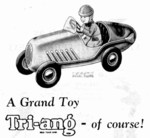Because the board games teach kids what their parents don't have time to say, Greg Costikyan has an in-depth analysis of Candy Land, the board game created by Eleanor Abbot and first published by Hasbro in 1949. Costikyan lifts the lid on the sociological pot, and it sure tastes sweet:
Next, let us consider the role of Candy Land in the acculturation of the American child. The characters represented in the game, through whose desmenses the players pass, are all representations of sickly, in many cases objectively repulsive, sweets: Princess Frostine, the Gingerbread People, Mr. Mint, Gloppy the Chocolate (formerly Molasses) Monster. There's a clear message to the American child here, one our business establishment is at pains to transmit through all forms of media -- most importantly, of course, through the thundering waterfall of commercial blandishment none of us is permitted to escape, whatever media we peruse. That message is, of course: CONSUME. Consume candy. Consume everything. But for children, candy above all; the natural childish instinct to like what in more mature mouths is repulsively lachrymose is the key, the first way in for inculcation of the consumer instinct. Candy good. Consume candy. Whine at your parent until she, or as it may be, he, buys you the packet of Lifesavers....Thus, while Abbot no doubt had no such intention for her game, Candy Land also serves as an important element in the indoctrination of American youth in the cult of excessive consumption and extravagant and unnecessary use of resources, the fundament of our society and economic growth since the end of the Second World War.Along with Chutes & Ladders, Candy Land is the first board game the kid has learned to play--she plays it with her grandmother. I always assumed it simply served the purpose of teaching the mechanics of a game: progression, chance, taking turns, winning & losing. Little did I know. Meanwhile, my vocabulary card for the day is already full, and it's not even breakfast.
Candy Land [playthisthing.com via boingboing]



Snakes. Snakes & Ladders. Don't be cowed by boardgame bowdlerization.
We were just talking about that in the lift this morning on the way to the tube.
Of course, there are all those children addicted to sushi because of playing Go Fish.
And when we were a bit older, perhaps 11, me and my friend played LIFE backwards; we called it The Game of Death, and thought it was very funny.
Add to the list of what Candyland can teach kids: desire. I have a deep recollection of feeling a physical yearning in the center of my body when I first laid eyes on that candy cane forest. I didn't feel such strong lust again until puberty.